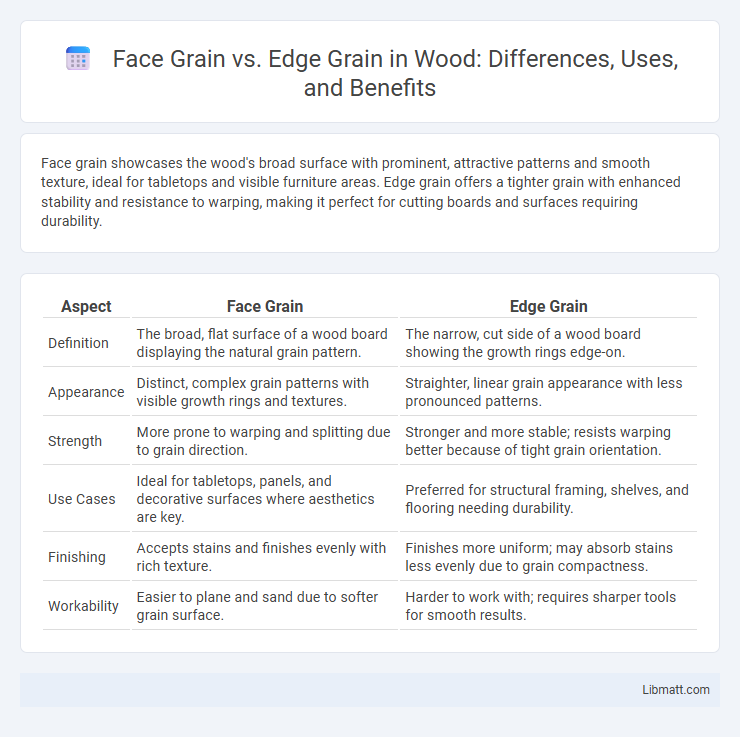Face grain showcases the wood's broad surface with prominent, attractive patterns and smooth texture, ideal for tabletops and visible furniture areas. Edge grain offers a tighter grain with enhanced stability and resistance to warping, making it perfect for cutting boards and surfaces requiring durability.
Table of Comparison
| Aspect | Face Grain | Edge Grain |
|---|---|---|
| Definition | The broad, flat surface of a wood board displaying the natural grain pattern. | The narrow, cut side of a wood board showing the growth rings edge-on. |
| Appearance | Distinct, complex grain patterns with visible growth rings and textures. | Straighter, linear grain appearance with less pronounced patterns. |
| Strength | More prone to warping and splitting due to grain direction. | Stronger and more stable; resists warping better because of tight grain orientation. |
| Use Cases | Ideal for tabletops, panels, and decorative surfaces where aesthetics are key. | Preferred for structural framing, shelves, and flooring needing durability. |
| Finishing | Accepts stains and finishes evenly with rich texture. | Finishes more uniform; may absorb stains less evenly due to grain compactness. |
| Workability | Easier to plane and sand due to softer grain surface. | Harder to work with; requires sharper tools for smooth results. |
Introduction to Face Grain and Edge Grain
Face grain refers to the wood surface cut parallel to the growth rings, showcasing prominent grain patterns and providing a smooth, attractive finish ideal for visible furniture surfaces. Edge grain is the wood cut perpendicular to the growth rings, offering a straighter grain pattern with increased durability and resistance to warping, commonly used for table tops and cutting boards. Understanding the differences between face grain and edge grain allows woodworkers to select the best wood orientation for aesthetics and strength in their projects.
Key Differences Between Face Grain and Edge Grain
Face grain wood refers to the surface showing the broad, flat side of the tree's growth rings, characterized by a smooth texture and prominent grain patterns, making it ideal for furniture and visible surfaces. Edge grain displays the narrow edge of the growth rings, offering a straighter, more uniform appearance with enhanced stability and resistance to warping, often used in cutting boards and worktops. Understanding these key differences helps you choose the right grain orientation for durability, aesthetics, and functionality in woodworking projects.
What is Face Grain?
Face grain refers to the orientation of wood fibers running parallel to the wide surface of a board, showcasing the most attractive and prominent grain patterns. It is often preferred for visible surfaces like tabletops and cabinetry due to its smooth texture and visually appealing lines. Understanding face grain helps you select the best wood for both aesthetic appeal and strength in your woodworking projects.
What is Edge Grain?
Edge grain refers to the wood surface revealed by cutting along the tree's vertical growth rings, exposing the narrow, straight grain lines that run parallel to the board's length. This grain orientation offers increased stability and resistance to warping compared to face grain, making it a preferred choice for flooring, cutting boards, and furniture edges. Edge grain also displays a subtle, linear texture that enhances durability while providing a smooth, refined aesthetic.
Aesthetic Appeal: Face Grain vs Edge Grain
Face grain wood features the broad, flat surface of the plank, revealing the intricate, natural patterns of grain and knots that enhance aesthetic appeal in furniture and cabinetry. Edge grain, displaying the narrow, vertical lines, offers a more uniform and subtle texture, ideal for minimalist, sleek designs. Choosing between face grain and edge grain depends on the desired visual impact, with face grain providing character and warmth, while edge grain delivers clean, understated elegance.
Durability and Strength Comparison
Face grain offers greater durability and strength due to the wood fibers running parallel to the surface, providing better resistance to wear and impact. Edge grain, while still strong, tends to be less durable over time as the fibers are oriented vertically, making it more prone to warping and dents. Your choice between face grain and edge grain will impact the longevity and robustness of wooden surfaces like cutting boards or furniture.
Best Uses for Face Grain Wood
Face grain wood features the prominent, wide growth rings that provide a smooth, attractive surface, making it ideal for furniture tops, cabinetry, and decorative panels. Its stability and visually appealing grain patterns enhance your projects where appearance and finish quality are crucial. Choosing face grain wood maximizes both durability and aesthetic appeal in fine woodworking.
Best Applications for Edge Grain Wood
Edge grain wood offers superior stability and durability, making it ideal for kitchen countertops and cutting boards that require resistance to warping and knife marks. Its uniform grain pattern provides a smooth, refined surface perfect for furniture, flooring, and cabinetry where longevity and strength are essential. Edge grain wood also performs well in high-traffic areas due to its balance of hardness and wear resistance.
Maintenance and Care Tips
Face grain wood requires regular cleaning with a soft cloth and mild soap to maintain its smooth surface, avoiding harsh chemicals that can damage the finish. Edge grain wood benefits from frequent oiling or waxing to protect its tighter grain from drying out and to prevent warping or cracking. Your care routine should also include protecting both grains from excessive moisture and direct sunlight to prolong their durability and appearance.
Which Should You Choose: Face Grain or Edge Grain?
Face grain provides a smooth, visually appealing surface ideal for tabletops and cabinetry, showcasing the wood's natural patterns and strength. Edge grain, known for its durability and resistance to warping, is the preferred choice for cutting boards and furniture needing structural stability. Choose face grain when aesthetics and smooth texture are priorities, while edge grain is better for functional, long-lasting wood surfaces.
Face grain vs Edge grain Infographic

 libmatt.com
libmatt.com